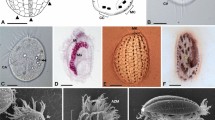Abstract
A new approach was developed for the determination of taxonomic and evolutional relationships among four genera of oligotrophic bacteria. The main idea of this approach is the algorithmized integrative analysis of the morphological and physiological specificity of these bacteria, their 5S rRNA sequences, fatty acid and lipid composition of their membranes, as well as their sensitivity to a large variety of antibiotics. It was shown that the genera Caulobacter and Hyphomonas are closely related to each other, but they are both distant from Hyphomicrobium species. The new genus, “Hyphobacter”, is placed between Caulobacter and Hyphomonas. Taxonomic heterogeneity was found to exist within the genera Caulobacter and Hyphomicrobium. Evolutional pathways from Caulobacter to Hyphomicrobium are proposed on the basis of the present data. No correlations were found between the cell morphology of the organisms and their geno-and chemotaxonomy.
Similar content being viewed by others
Abbreviations
- C-1:
-
one-carbon
- kB:
-
kilobases
References
Andreev LV, Akimov VN, Nikitin DI (1986) Peculiarities of fatty acid composition of the genus Caulobacter. Folia Microbiol 31:144–153
Beloni ZH, Avilov IA, Gromov BV (1984) The peculiarities of soil strains of budding of the bacteria genus Hyphomicrobium. Biol Sci 6:71–75 (in Russian)
Chumakov KM (1987) Evolution of nucleotide sequences. Sov Sci Rev D Physicochem Biol 7:51–94
Dagasan L, Weiner RM (1986) Contribution of the electrophoretic pattern of cell envelope protein to the taxonomy of Hyphomonas spp. Int J Syst Bacteriol 36:192–196
Ely B (1984) Genetic map of Caulobacter crescentus. In: O'Brien STJ (ed) Genetic maps — 1984. Cold Spring Harbor Laboratory, Cold Spring Harbor, New York, pp 206–208
Fox GE, Stackebrandt E, Hespell RB, Gibson J, Maniloff J, Dyer TA, Wolfe RS, Balch WE, Tanner RS, Magrum LJ, Stahl DA, Luehrsen KR, Chen KN, Woese CR (1980) The phylogeny of prokaryotes. Science 209:457–463
Gebers R, Moore RL, Hirsch P (1984) Physiological properties and DNA-DNA homologies of Hyphomonas polymorpha and Hyphomonas neptunium. Syst Appl Microbiol 5:510–517
Gebers R, Wehmeyer U, Roggentin T, Schlesner H, Kölbel-Boelke J, Hirsch P (1985) Deoxyribonucleic acid base composition and nucleotide distributions of 65 strains of budding bacteria. Int J Syst Bacteriol 35:260–269
Harder W, Attwood MM (1980) Biology, physiology and biochemistry of Hyphomicrobia. In: Perlman D (ed) Advances in applied microbiology, vol 26. Academic Press, New York, pp 303–359
Hirsch P (1974) Budding bacteria. Ann Rev Microbiol 28:391–444
Hirsch P, Conti SF (1964) Biology of budding bacteria. I. Enrichment, isolation and morphology of Hyphomicrobium spp. Arch Microbiol 48:339–357
Kölbel-Boelke J, Gebers R, Hirsch P (1985) Genome size determinations for 33 strains of budding bacteria. Int J Syst Bacteriol 35:270–273
Komagata K, Suzuki KI (1987) Lipid and cell-wall analysis in bacterial systematics. In: Colwell RR, Grigorova R (eds) Methods in microbiology, vol. 19 Academic Press, London, pp 161–207
Lane DJ, Pace B, Olsen GJ, Stahl DA, Sogin ML, Pace NR (1985) Rapid determination of 16S ribosomal RNA sequences for phylogenetic analyses. Proc Natl Acad Sci USA 82:6955–6959
Maniatis T, Fritsch EE, Sambrook J (1982) Molecular cloning. Cold Spring Harbor Laboratory, Cold Spring Harbor, New York
Nikitin DI, Chumakov KM (1986) The functional role of oligotrophic microorganisms. In: Jensen V, Kjoller A, Serensen LH (eds) Microbial communities in soil. Elsevier, London New York, pp 177–189
Nikitin DI, Nikitina ES (1978) Environmental processes of selfclarifing and bacterial parasites (genus Bdellovibrio). Nauka, Moscow, p 26 (in Russian)
Nikitin DI, Pitryuk IA (1983) The specificity of physiology of stalked bacteria of the genus Caulobacter. Izv Akad Nauk SSSR Ser Biol 2:293–298 (in Russian)
Nikitin DI, Pitryuk IA, Zagreba ED, Ghinovska MK, Yakobson YO (1984) The study of the oligotrophic bacteria by the infrared spectrometry method. Izv Akad Nauk SSSR Ser Biol 1:144–148 (in Russian)
Nikitin DI, Vishnewetskaja OYu, Zlatkin IV (1988) Clusterization of oligotrophic microorganisms based on their susceptibility to antibiotics and dynamic characteristics of membranes. Mikrobiologiya 57:262–267 (in Russian)
Poindexter JM (1981) The Caulobacters: ubiquitous unusual bacteria. Microbiol Rev 76:123–179
Pogwizd SM, Lerner SA (1984) Mechanisms of action of antimicrobial agents. In: Laskin AY, Lechevalier HA (eds) Handbook of microbiology, vol 6. CRS Press, Cleveland, pp 299–316
Stackebrandt E, Fisher A, Roggentin T, Wehmeyer U Bomar D, Smida J (1988) A phylogenetic survey of budding and/or prosthecate, non-phototrophic bacteria: Membership of Hyphomicrobium, Filomicrobium, Hyphomonas, Pedomicrobium, Caulobacter and “Dichotomicrobium” to the alpha-subdivision of purple non-sulfur bacteria. Arch Microbiol 149:547–556
Weiner RM, Devine RA, Powell DM, Dagasan L, Moore RL (1985) Hyphomonas oceanitis sp. nov., Hyphomonas hirschiana sp. nov., and Hyphomonas jannaschiana sp. nov. Int J Syst Bacteriol 35:237–240
Zavarzin GA (1960) The life-cycle and nuclear changes in Hyphomicrobium vulgare. Stutzer et Hartleb. Mikrobiologiya 29:38–42 (in Russian)
Author information
Authors and Affiliations
Rights and permissions
About this article
Cite this article
Nikitin, D.I., Vishnewetskaya, O.Y., Chumakov, K.M. et al. Evolutionary relationship of some stalked and budding bacteria (genera Caulobacter, “Hyphobacter”, Hyphomonas and Hyphomicrobium) as studied by the new integral taxonomical method. Arch. Microbiol. 153, 123–128 (1990). https://doi.org/10.1007/BF00247808
Received:
Accepted:
Issue Date:
DOI: https://doi.org/10.1007/BF00247808




